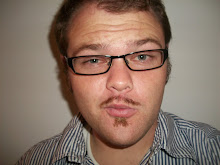I'm going to London: home of kangaroo burgers at Borough Market and beautiful Italian women. It will probably drain me (rephrase: it will drain me), but I have a legitimate reason for going there. The book I found in Zurich that is out of reach because of funding is also in the British Library. And I've done research there already, so I know how things roll and can get to it (I hope) without too much hassle. I realize that the British pound is worse for my budget than the euro, but it's London. London is kind of on the way to Madrid...
~
Thank you, tilde. So I left Lisbon on Monday. I found a train to Coimbra, where I spent two nights. I hunkered down for the night at the top of a very tall, very starving-artist-ic apartment on a hill with three students who speak lots of Spanish and some Portuguese. Pepa was officially my host, and her housemates Antonio and Leire were very nice.Pepa is a painter and paints mustaches on herself, Antonio is very well read and he and I talked about everything from Alfred Hitchcock to Ricky Martin, and Leire has an amazing lady mullet and can make perfect smoke rings. I had my own room, and they let me paint on the wall. So I painted one of my recent poems, which was actually Pepa's idea.
Is my beard not glorious?
That wall is going to be worth at LEAST $17 one day.
Coimbra is a beautiful city. It is built around the University of Coimbra, which was established in 1290. It was established by King Dinis, originally in Lisbon until it was moved to Coimbra around 1308 for a number of political reasons (that and the students didn't get along with the people of Lisbon). Nowadays it is a beautiful mix of the old and the new, with students from all over the world. I think I heard more Spanish than Portuguese. Either way, the pizza joint across the street is good, which is necessary for any higher education to be complete. Pics:
King Dinis. Somebody climbed him and gave him a noose. Disruptive and hilarious.
A garden I found with poetry written by medical students carved into the landscape.
The tower and main facade of the old University of Coimbra.
The New See.
The much more interesting and harder to get to Old See.
Completely random dragon statue near the stained-glass bridge. Finally modern art I appreciate.
Manuel Alegre: poet, UofC alumnus, socialist, and Salazar-dictatorship opponent.
Artist got bored and left out the middle. Anyone else reminded of the movie "Little Giants"?
~
I left Coimbra on Wednesday and headed to Penafiel, Portugal, which is near Porto, the second-largest city in Portugal. I am staying with a married couple Miguel and Ana. Miguel is a policeman and Ana is a nurse. When I got in, Miguel came and got me. He drove me through Penafiel, which took about five minutes, and then to their apartment, which is wonderful. I have an amazing view and a very large bed, not to mention my own bathroom and all the Coca-cola and cereal I can handle. I spent all day yesterday and most of today in Porto, which I instantly loved (there are six bridges). Pics:
The coast at 7am.
Driving around Porto in Miguel's cop car.
The spot in Porto where the most drug traffic takes place (first place Miguel showed me).
The first bridge (coming from the ocean up the river).
Tower of the Clerics. Bells chimed "Ode to Joy" at 10am.
City hall. Love this building.
I bought Greenmantle, the sequel to John Buchan's The 39 Steps
at the very old and extremely beautiful Lello Bookstore.
São Bento train station.
My favorite tile painting in São Bento train station.
The See.
View of Porto's waterfront (river here, ocean to the west) from the Luis I Bridge.
Thumbs up for auto timers on crappy cameras.
View of the Luis I Bridge from the monastery.
The São Francisco Church.
Dead people in the floor at the São Francisco catacombs.
Luis I Bridge, underside.
Kids jumping from the Luis I Bridge. It doesn't look as high as it was.
I wanted to jump, but, alas, there was no one to hold my wallet, phone, books, and camera.
I don't talk to strangers. Unless I want to sleep over at their house.
Happy to be back in Penafiel for one last sleep.
Miguel laughed at me when I posed.
This is the Penafiel church, patterned after the Sacre-Coeur.
It's not as big, because the builders kept a lot of the money. For taxes, I'm sure.
~
Today, Portugal. Tomorrow England. Tuesday, Spain.
Sing with me! "Rule, Britannia, Britannia, rule the sea..."


